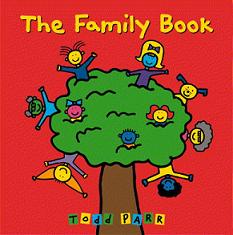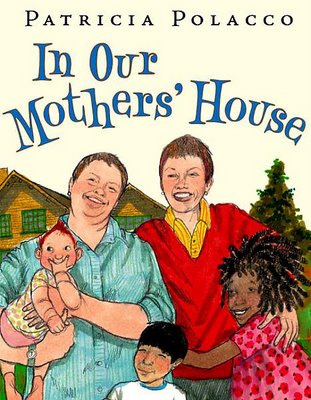(applause for alliteration, please)
This month we’ve been working on restoring two children’s picture books teaching tolerance for different types of families. Though they are quite different in content, tone, reading level and appropriateness, their challenges parallel one another immensely.

Book one is The Family Book by Todd Parr, a peppy, colorful and simple picture book teaching that families might be different, but all families share similarities. For example: all families like hugging. Also, all families are sad when a loved one passes. The book has been removed from schools in Erie, IL along with all GLSEN-endorsed materials and will not be returned.
Book two is In Our Mothers’ House by Patricia Polacco. Geared at an older audience (ages 7-10) and embellished by lovely water-color illustrations, the book is a very (very) positive portrayal of the love between members of a non-traditional family in Berkeley, CA. The book has been placed behind the shelves of school libraries in Davis County, UT and may only be accessed with a parental permission slip.
What these books have in common is that they acknowledge a reality: some families have same-sex parents. Not altogether surprisingly, what they also share is the ability to offend those with certain beliefs about norms and conventions.
Books like The Family Book and In Our Mothers’ House can be used as educational tools to foster tolerance for diverse types of families and cut back on potential bullying.

In each case, much of the discussion revolves around what is “appropriate” to teach young children and when, and how much parental control comes into play. The complaining parents in both of these cases cited a wish to control if and when they inform their children that some of their classmates have two moms or two dads.
In a story today in the Salt Lake Tribune, Weston Clark, who grew up in Davis County and now is a stay-at-home father to the son he and his partner adopted, said he reached out to the school board. Clark is upset by the implication that his family is “inappropriate.”
“What exactly do you find “inappropriate” about my family?” he said. “We’re great citizens, we pay our taxes, we go to work, we keep up our yard.”
Not all families have one mother, one father, 2.5 children, a dog and abundant happiness without complications. In fact, I’m willing to bet few families do. Literature, whether it is children’s or adult’s, exists to reflect Life–in its multitudinous forms–back at us and make it recognizable, bearable, comprehensible, able to be celebrated.
These books make a difference for families who feel different. Here are a couple testimonials Todd Parr has received for his books, including The Family Book:
“In November of this past year I flew to India to meet and bring home my newly adopted daughter..Reading books to her wasn’t initially a pleasure due to her lack of language and often it was hard to find many stories that she could identify with. Until, ‘It’s Okay to be Different’ and your ‘Family Book’. These books brought pure joy to her eyes, she loves them! (She) loves to read, is ‘It’s Okay to Be Different’. I cry almost every time she reads it… It’s so beautiful. Your books have helped my daughter feel accepted…Truly ‘okay’.”
and…
“I am a pastor of a United Methodist congregation. I and my team of Sunday school teachers are developing a Sunday school curriculum using “The Family Book” as inspiration. We are reading/referencing your book and then providing positive and affirming scriptures from the Bible on the wideness of God’s family, an inclusive vision of families, and the diversity of families within our congregation.”
The objectors in these cases are worried about the messages being conveyed to their kids by these two books. I’d ask, what message is being conveyed to these kids by removing these books or keeping them in the dark?
Thanks to Little, Brown, publisher of The Family Book for providing these testimonials.

